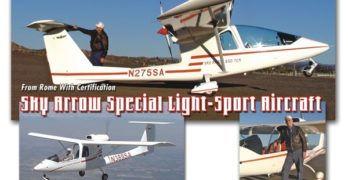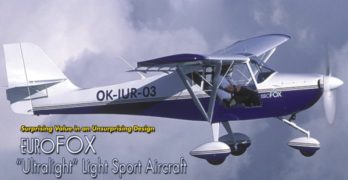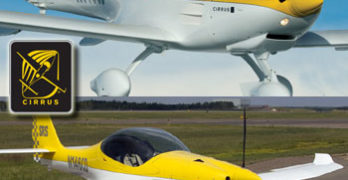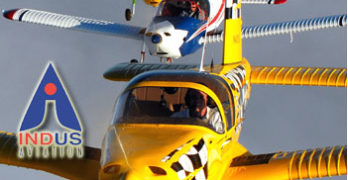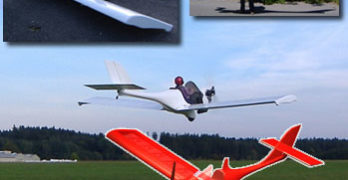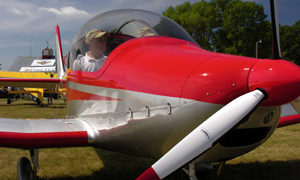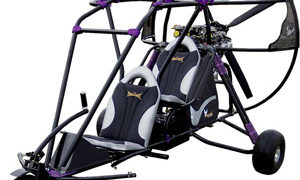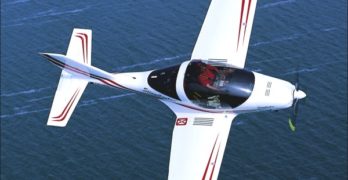Ultralight pilots
may not believe the Sky Arrow has achieved Part 23 certified status the same as a Cessna or Cirrus, but it has done precisely that. This sleek Italian tandem 2-seater earned European JAR/VLA certification and, after careful review, FAA gave its approval under international reciprocity agreements.
That makes the Sky Arrow something like the RANS S-7, which won approval under FAA’s last new certification program, Primary category. As a side note, the Kansas company also received its S-LSA airworthiness certificate with less challenge than companies that had not taken the earlier effort
Therefore, once FAA introduced the Light-Sport Aircraft regulation, few were surprised that the Sky Arrow could win approval. In fact, the aircraft was number 18 out of ranks that have now swelled to 40 new models approved.
Let’s forget about FAA approval for the moment and focus on the Sky Arrow’s ability to fly much like an ultralight.
Search Results for : electric
Not finding exactly what you expected? Try our advanced search option.
Select a manufacturer to go straight to all our content about that manufacturer.
Select an aircraft model to go straight to all our content about that model.
Surprising Value in an Unsurprising Design
On September 1, 2004, when the Federal Aviation Administration (FAA) released the long-anticipated Sport Pilot and Light-Sport Aircraft regulations, a new aviation segment called light sport aircraft (LSA) was created. Some saw LSA as a bridge between ultralights and general aviation aircraft, but are LSA so different from ultralights? The answer is a mixed yes and no.
Yes, many aircraft look different in that the extra weight they may possess allows them to have full composite fuselages, a panel full of instruments even including fancy glass cockpit hardware, plus they can be delivered ready to fly even as 2-seaters. That’s different than our ultralight trainers or our amateur-built recreational aircraft that resemble those trainers. Prices for these light sport aircraft have pushed them beyond the budgets of many pilots.
On the other hand, these aircraft needn’t be all that different from ultralights. The new rule doesn’t require that they weigh the maximum 1,320 pounds.
Cirrus SRS Orders + a dozen LSA & an Ultralight
SEBRING 2008 — Opening day started fast with press announcements from Cirrus — the GA company started taking orders for their SRS — and from Flight Design as the company unveiled their much-anticipated CTLS. But that was hardly all as the fourth Sebring Expo got going. I found a dozen newsworthy airplanes at the event and I may have missed some (I’ll keep searching). *** Gobosh introduced the 800XP, a sleek composite companion to the metal 700S. Sport Aircraft Works offered their just approved Dynamic LSA with fixed gear and prop. Skykits showed their shiny new Rampage with electric slots and Fowler flaps, and Urban Air USA showed their Lamabada LSA motorglider for the first time at a U.S. airshow. SportairUSA revealed their third generation Sting S3 with a new wing design and other updates.
“Refresh ’08,” IndUS Promotes Two Revised Models
We’re barely two weeks away from the season-launching Sebring LSA Expo. As 2007 ends and companies prepare for 2008, new models will be on display at Sebring and upgraded versions will further entice consumers. Among the latter are two refreshed models from Texas-based IndUS Aviation. *** Marketing man Scott Severen sent a long list of alterations made to the all-metal Thorpedo LP120 and LP85. They incorporate IndUS-completed aerodynamic refinements (new engine cowl, wing tips, and gear leg fairing) plus canopy styling and wear improvements, new boarding steps, new lowered seats for taller occupants, electrical system upgrades plus several interior or ergonomic refinements. Other updates focus on comfort and safety. It shows IndUS has been listening to customers and acting on that knowledge. *** Severen says IndUS will be at Sebring with no less than 8 aircraft. And bringing this fleet allows IndUS to make an unusual offer: Upon completion of signed purchase order and a $5,000 deposit, the aircraft of customer’s selection at the show will be flown free of charge to the customer’s home airfield by one of Severen’s sales team.
See Nothing New in Part 103 Airplanes? Look Again!
Even though FAA has said Part 103 will not be changed, many pilots see few fixed wing airplane choices truly meeting the definition.
Some trikes and powered parachutes can manage it but many lament, “Yeah, but no three-axis designs.” If you agree, be prepared to eat your words. Here comes Interplane’s ZJ Viera.
The brand-new composite design is no dream. It’s gone through a proof-of-concept stage and is now flying as a preproduction prototype. Those attending Sebring Expo 2008 can visit importer LSA America‘s display.
Does it genuinely make weight, the toughest part of F.A.R. Part 103? Based on factory info…YES, and by a generous margin!…thanks to modern materials and simple design.
Will ZJ be affordable? “Yes,” says former Interplane owner Ralph Mandarino. The company priced a basic ready-to-fly monowheel ZJ at $19,800. They’re flying it with the Hirth F33 but as it appears well under the max empty weight of 254 pounds, ZJ engineer and Interplane CEO Marek Ivanov could investigate other engines including four-stroke or electric.
Kappa KP-5 “B” Exhibited in EAA’s LSA Mall
As with EAA’s premiere LSA Mall at AirVenture 2005, the area is proving a huge hit again in 2006 and drawing large crowds interested in LSA. Not all 38 SLSA are present but all the leading brands (measured by deliveries) are on exhibit. *** One new model revealed at the event is Kappa Aircraft‘s KP-5. Though it was not rebadged, I’d at least call it a “B” model for its several significant changes. Most notable in the staggered seat design — with the left seat positioned several inches in front of the right seat — is a much wider 47-inch cabin. “Flight schools like the extra width so they can handle bigger students,” said importer Ed Miller. The “B” KP-5 has thicker wing skins (.027), filled pop rivets, and electric actuation for its excellent Fowler flaps (an earlier manual lever took some muscle). Inside a center console is narrower giving more foot room.
The EuroFox Offers Affordable Quality
Repatriate means “to restore or return to the country of origin.” That’s exactly what’s happening with the Aeropro EuroFox, an Eastern European-built light-sport aircraft (LSA) based on American design work. It’s coming to this country as a ready-to-fly LSA through importer Rollison Light Sport Aircraft (RLSA).
Just as a car made in Detroit may incorporate a considerable number of parts that were manufactured overseas, LSA can be a combination of United States- and foreign-built parts as well. That’s not unusual in the aviation world. Consider that a new Boeing airplane is likely to have many parts manufactured in other countries. When Boeing competes against Airbus, it may be important to give some work to a country that may buy billions of dollars of airliners. Therefore, even a Boeing aircraft is not 100 percent made in America.
In the LSA world, aircraft manufactured in foreign countries may be delivered to the United States without instruments or other accessory equipment, or that equipment may have been built in the United States and shipped overseas for installation in the aircraft.
Aeropro EuroFox
His Rollison Light Sport Aircraft (RLSA) company has been building a fleet of aircraft for sale from European sources. Rollison has represented numerous brands over the years he’s been involved in light-sport aviation. First he represented American brands and later European. Recently he’s traveled to South America to see what’s available. Today, Rollison sells the Remos G-3 Mirage, the Ikarus-Comco C42, and the EuroFox. He’s associated with Allistair Wilson who is making his own Astra trikes. Of the fixed-wing models in RLSA’s hangar, the EuroFox is the most modestly priced with the C42 next highest and the G-3 as RLSA’s top-of-the-line model.
More Than Familiar?
Many Ultralight Flying! readers will say the EuroFox looks to be a copy of a Kitfox. In fact, says Rob Rollison, this simply isn’t true.
The EuroFox certainly shares heritage with the Kitfox but is actually a downstream development of the Avid Flyer. In the Slovak Republic, where the four founders of Aeropro live, plans were used to build an Avid.
SLSA Number 50 Is Powrachute’s AirWolf 912
Right at the two year point since the first Special Light-Sport Aircraft approval, Powrachute’s AirWolf 912 powered parachute brings the certified fleet total to 50 SLSA models. Forty two of them are airplanes (the fixed wing variety) with five being weight shift (trikes), and three powered parachutes. Among PPCs, the Canadian Summit II was first in 2006 followed by Infinity’s Commander early this year. *** Team Powrachute loads up their AirWolf 912 with the electric start 100-hp Rotax, a four-blade Warp Drive composite prop with Super Hub, an Electronic Info System with instrument pod, extended footbars, spun aluminum wheels, tundra tires, dual hydraulic main gear suspension paired with springs, stainless exhaust, strobe light, electric fuel pump, dry cell battery, four-point seat belts, oversize canopy carry bag with line socks and a choice of parachute sizes and colors. While some complain about the cost of LSA, here’s one with a four-stroke engine for less than $31,000.
StingSport, a Carbon Fiber LSA
A fully loaded, top-of-the-range aircraft
Eastern European aircraft are expected to factor massively in the coming wave of light-sport aircraft (LSA) available to Americans. Several designs have already begun to attract interest as we get closer to approval of the ASTM International consensus standards that will govern the design, construction, and maintenance of these machines. One airplane that generated significant interest at EAA AirVenture Oshkosh for the last three years is the TL-2000 Sting.
Common to designs we’re seeing from Eastern Europe, the TL-2000 Sting from TL Ultralight in the Czech Republic is a sleek, composite aircraft with impressive performance and handling. The Sting series evolved from an earlier TL Ultralight design called the TL-96, and both aircraft cater to the European ultralight market, which has allowed the manufacture of LSA-category aircraft under European microlight regulations. Now, the TL-2000 and TL-96 are being reworked to meet LSA requirements. The planes have been renamed the StingSport and StarSport respectively to designate the aircraft that will be LSA-compliant.
- « Previous Page
- 1
- …
- 49
- 50
- 51
- 52
- 53
- …
- 67
- Next Page »


